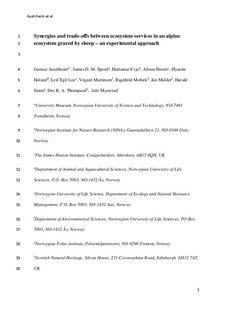Synergies and trade-offs between ecosystem services in analpine ecosystem grazed by sheep – An experimental approach
Austrheim, Gunnar; Speed, James David Mervyn; Evju, Marianne; Hester, Alison; Holand, Øystein; Loe, Leif Egil; Martinsen, Vegard; Mobæk, Ragnhild; Mulder, Jan; Steen, Harald; Thompson, Des B.A.; Mysterud, Atle
Journal article, Peer reviewed
Permanent lenke
http://hdl.handle.net/11250/2409084Utgivelsesdato
2016Metadata
Vis full innførselSamlinger
- Institutt for naturhistorie [1213]
- Publikasjoner fra CRIStin - NTNU [37290]
Sammendrag
Domestic livestock drives ecosystem changes in many of the world’s mountain regions, and can be the dominant influenceon soil, habitat and wildlife dynamics. Grazing impacts on ecosystem services (ES) vary according to densities of sheep, butan ES framework accounting for these is lacking. We devised an experiment to evaluate synergies and trade-offs of ESs andcomponents of biodiversity affected by sheep density at the alpine landscape scale in southern Norway. We examined the effectsof increased (80 per km2), decreased (0 per km2) and maintained sheep densities (25 per km2) on ‘supporting’, ‘regulating’and ‘provisioning’ services and biodiversity (plants, invertebrates and birds). Overall, ESs and biodiversity were highest atmaintained sheep density. Regulating services, including carbon storage and habitat openness, were particularly favoured bymaintained densities of sheep. There was no overall decline in ESs from maintained to increased sheep densities, but severalservices, such as runoff water quality, plant productivity and carbon storage, declined when grazing increased. Our study providesexperimental evidence for a positive effect of grazing on ES, but only at maintained low sheep densities. By identifying ESand biodiversity components that are traded-off at decreased and increased grazing, our study also demonstrates some of thenegative impacts on ecosystems that can occur in mountain regions if management does not regulate herbivore densities.
Herbivory; Ecosystem services; Livestock; Management; Optimal stocking levels; Overgrazing; Threshold
